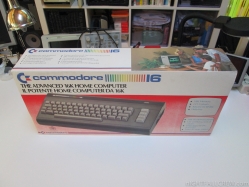Commodore 16 Boxed Mint Condition

Autopsy:
from Wikipedia:
The Commodore 16 was a home computer made by Commodore with a 6502-compatible 8501 CPU, released in 1984. It was intended to be an entry-level computer to replace the VIC-20 and it often sold for 99 USD. A cost-reduced version, the Commodore 116, was sold only in Europe.
The C16 was intended to compete with other sub-$100 computers from Timex Corporation, Mattel, and Texas Instruments (TI). Timex’s and Mattel’s computers were less expensive than the VIC-20, and although the VIC-20 offered better expandability, a full-travel keyboard, and in some cases more memory, the C16 offered a chance to improve upon those advantages. The TI-99/4A was priced in-between Commodore’s VIC-20 and Commodore 64, and was somewhat between them in capability, but TI was lowering its prices. On paper, the C16 was a closer match for the TI-99/4A than the aging VIC-20.
Commodore president Jack Tramiel feared that one or more Japanese companies would introduce a consumer-oriented computer and undercut everyone’s prices. Although the Japanese would soon dominate the U.S. video game console market, their feared dominance of the home computer field never materialized. Additionally, Timex, Mattel, and TI departed the computer market before the C16 was released.
Outwardly the C16 resembled the VIC-20 and the C64, but with a dark gray case and light gray keys. The keyboard layout differed slightly from the earlier models, adding an escape key and four cursor keys replacing the shifted-key arrangement inherited from the C-64 and VIC. Performance-wise located between the VIC-20 and 64, it had 16 kilobytes of RAM with 12 KB available to its built-in BASIC interpreter, and a new sound and video chipset offering a palette of 128 colors (in reality 121, since the system offered 16 base colors with 8 shades per color, but black always remained black, with all 8 shades), the TED (better than the VIC used in the VIC-20, but lacking the sprite capability of the VIC-II and advanced sound capabilities of the SID, both used in the C64). The ROM resident BASIC 3.5, however, was more powerful than the VIC-20′s and C64′s BASIC 2.0, in that it had commands for sound and bitmapped graphics (320×200 pixels), as well as simple program tracing/debugging.
source: wikipedia
















Recent Comments